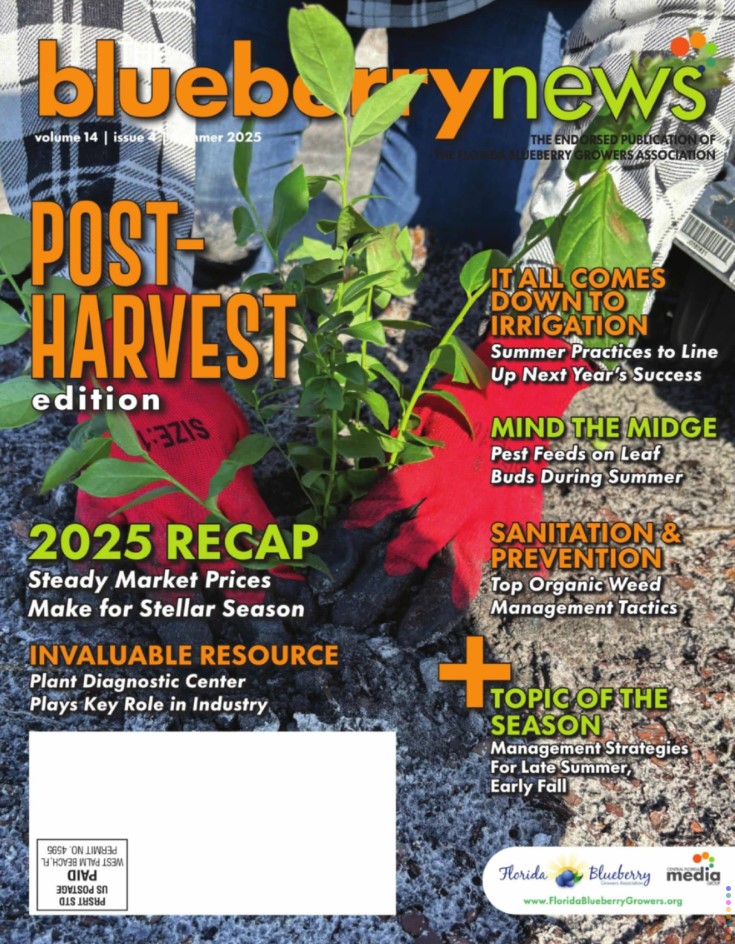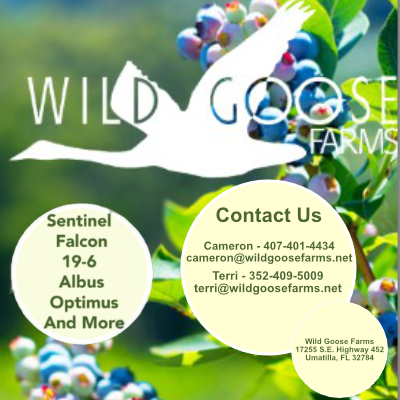Do Rootstocks Have a Place in Commercial Blueberry Production?
Ongoing research in our program is evaluating the potential use of sparkleberry (Vaccinium arboreum) as a rootstock for southern highbush blueberry (SHB). Blueberry plants are shallow-rooted and require soils with low pH and high organic matter content. Under current management systems in the southeastern U.S., SHB is frequently subjected to a variety of stresses including periodic drought stress, and adverse soil conditions such as insufficient soil organic matter and/ or high soil pH. Moreover, the multi-cane SHB crown is not adapted to the current mechanical harvester designs because catch plates do not seal effectively around the base of plants. The result is fruit dropping to the ground during machine harvesting (see Figure 1).

A narrower, single-trunked, crown would reduce ground drops during machine harvesting. Sparkleberry is native to the southeastern U.S., has a deeper root system than SHB, and tolerates lower soil organic matter content and a broader soil pH range than blueberry. Sparkleberry has a tree-like growth habit with tendencies for a single trunk, which is better suited for machine harvesting than the multi-caned crown of SHB. Southern highbush blueberry grafted onto sparkleberry exhibits the single-trunk growth habit (see Figure 2).

Two field experiments were established in 2011; one at the UF/ IFAS Plant Science Research and Education Center near Citra, Florida and the other at Straughn Farms near Archer, Florida. Each site consists of ‘Meadowlark’ and ‘Farthing’ grown as own-rooted plants and as plants grafted on sparkleberry seedling rootstocks.
Each plant type is grown in pine bark amended sandy soil and in non-amended sandy soil. Following planting, grafted plants initially grew slower and had lower yields than own-rooted plants. However, by year three after planting, plant canopy size and yield of grafted plants were similar to, or greater than, own-rooted plants when grown under the same soil conditions. By years four and five, grafted plants tended to have more vigor and greater yields than own-rooted plants grown in the same soil treatment, especially in the non-amended soil. During years four and five, berry yield for grafted plants in non-amended soil was similar to, or greater than, berry yield of own-rooted plants in amended soil. Canopy size was similar for grafted plants on years, symptom progression was more advanced on own-rooted non-amended soil compared and own-rooted plants on, soil (see Figure 3).

Cumulative yield (2013 – 2017) was greater for grafted plants than for own-rooted plants when grown on non-amended soil, and similar to grafted and own-rooted plants when grown on amended soil. Cumulative berry yield of grafted plants on non-amended soil was not different from cumulative berry yield of own-rooted plants on the amended soil. Overall, average respect to sprouting from the crown and vigor transferred to the berry weight tended to be slightly greater for grafted ‘Meadowlark’ compared to own-rooted ‘Meadowlark;’ however, no consistent differences were found for average berry weight of ‘Farthing.’ There were no consistent differences for internal berry quality between grafted and own-rooted plants.
Machine harvest was simulated at the Archer location using handheld shakers and catch frames. Ground drops were reduced by about 35 percent for the single-trunk, grafted, plants compared to the multi-caned, own-rooted, plants during simulated machine harvesting.
Bacterial leaf scorch symptoms were observed on own-rooted ‘Meadowlark’ at the Citra site in 2014. During the following years, symptom progression was more advanced on own-rooted ‘Meadowlark’ than on grafted ‘Meadowlark.’ By the fall of 2017, eight percent of the grafted ‘Meadowlark’ plants died from leaf scorch compared to 40 percent of the own-rooted ‘Meadowlark.’ ‘Farthing’ was not significantly affected by leaf scorch.
Considerable variability was observed among the initial sparkleberry seedling rootstock population used in this study with respect to sprouting from the crown and vigor transferred to the scions. High vigor and low sprouting selections have been made from the initial sparkleberry seedling population for further testing as blueberry rootstocks. Our results to date suggest that reduced reliance on pine bark, improved adaptation to machine harvesting, and increased tolerance to blueberry leaf scorch may be possible with sparkleberry rootstocks. However, further testing is needed to fully evaluate the performance of different cultivar/rootstock selection combinations under a variety of field conditions.





